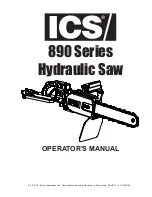
IE
NI
13
GB
Otherwise, the leaking of battery luid might damage the
device.
-
Do not place the batteries on radiators or expose them for a
prolonged period to strong sunlight; temperatures above
45 ° could damage the device.
2. Initial mounting of the laser module:
-
Mount the laser using the two Phillips head screws (z),
Fig. 15.
(Figures 16-20)
3. Adjust the saw blade (4) to a max. cutting depth, move to
the 0° position and lock in place.
4. Dismantle the saw blade guard (2)
(not during initial assembly).
5. Release the two attachment bolts (28) and remove the table
insert.
6. Loosen the ixing screw (29) (use the open-ended spanner
AF8 supplied).
7. Push the riving knife (3) upwards.
8. The distance between the saw blade and riving knife (3)
should be between 3 mm and max. 5 mm, (Figure 18).
9. Retighten the attachment bolts (29) and mount the table insert
(5).
10. Reattach the saw blade guard (2).
Mounting / dismounting
the Saw Blade Guard
(Figures 19)
On irst assembly, the assembly of the saw bla
-
de protection has already been carried out in
the previous assembly step.
1. Loosen the knurled nut and wing nut (31) of the saw blade
guard (2). Place the saw blade guard (2) from the top onto
the riving knife (3).
2. Mount the bolt with the knurled nut and washer (31) so that
the bolt sits irmly in the slot.
3. Do not overtighten the bolt (31). The saw blade guard must
be able to move freely.
4. Dismantling is carried out in reverse order. Caution! Before
you start sawing, the saw blade guard (2) has to be lowered
onto the item being sawn.
Replacing the Table Insert
(Figures 16 and 20)
1. If it is worn or damaged, the table insert (5) has to be repla-
ced, as otherwise there is an increased risk of injury.
2. Remove the 2 countersunk screws (28).
3. Take out the table insert (5).
4. The new table insert (Order-Nr.: 91104566) is mounted in
reverse order.
Attaching/changing the Saw Blade
(Figure 21)
1. Caution! Remove the mains plug and wear protec-
tive gloves.
2. Dismantle the saw blade guard (2).
3. Remove the table insert (5) by releasing the two countersunk
screws (28).
4.
Place the hexagon socket key (h) (HX 6) on the bolt and use the
jaw spanner (k) (SW 22) to stop the motor spindle from turning.
5. Caution!
Turn the bolt in the direction of rotation of the saw
blade. Remove the loosened screw.
6. Remove the outer lange and take the old saw blade off the
inner lange by pulling downwards and diagonally.
7. Clean the saw blade langes carefully with a wire brush
before attaching the new saw blade.
8. Insert and tighten the new saw blade in reverse order.
Caution! Note the direction of motion; the slope of
the cutting edge of the teeth must face the directi-
on of motion, i.e. forwards (see the arrow on the
saw blade guard.
9. Reattach and adjust the table insert (5) and the saw blade
guard (2).
10. Before you work with the saw again, a check must be
carried out to ensure that the protective devices are working
properly.
Connect the suction device
(Fig. 14)
1. Attach a suction hose to the suction adapter (18). If
necessary, secure the suction hose with a hose clamp to
prevent it from slipping off the suction adapter (18).
2. A household vacuum cleaner is not suitable as a suction de-
vice. Use a multi-purpose vacuum cleaner or a swarf extracti-
on machine.
Before putting into operation
• The machine must be set up on a stable surface, i.e. on the
base or similar item. For this, use the drill holes which are
located in the frame of the machine. For safe use on a work
bench, four mounted rubber feet are provided
(ig. 8).
• Before the machine is put into operation, all covers and safety
devices must be properly attached.
• The saw blade must be able to move freely.
• In the case of wood which has already been worked with,
check for foreign bodies such as nails or screws etc.
• Before pressing the on/off switch, make sure that the saw bla-
de is correctly attached and that moving parts are free-running.
• Before connecting the machine, check that the data on the
type plate matches those of the mains system.
• The machine must only be connected to a properly installed
safety socket which is protected by a fuse of at least 16A.
• If possible, connect the device only to a socket with a residual
current circuit breaker (RCCB) with a tripping current of not
more than 30 mA.
Prior to irst use, check the tightness of the
outer lange of the saw blade.
Summary of Contents for 298657
Page 5: ...max 3 5 mm 16 18 14 17 19 15 13 38 37 36 18 3 29 31 2 5 28 28 35 a 20 2 5 30 f c e z 5...
Page 34: ...34...
Page 35: ...35 2018 04 05 rev02 op...
Page 36: ...23 25 21 24 26 22 32 16 p 39 6 h k 6 39 6 m 16 n o 27 28 39 45 m r 6 4 39 6 36...
Page 37: ...31 29 m 33 39 34 36 2 32 33 1 2 6 34 6 2 z 35 36 4 6 40 38 37 35 35 19 30 6 p q 37...
Page 38: ...38 39 37 39 40 38...
Page 39: ...39...














































